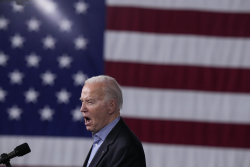
The presidential election is about to get much more stressful for everybody.
As the United States heads towards the 2024 presidential election, a palpable sense of anxiety grips both major political camps. Incumbent President Joe Biden and former President Donald Trump, the leading contenders for the Democratic and Republican nominations respectively, face a familiar yet formidable challenge: the 3rd-party vote. Historically, third-party candidates have often been dismissed as long-shot hopefuls with little chance of winning. However, their potential to siphon off crucial votes from the main contenders means that both Trump and Biden have valid reasons to be terrified of this looming threat.
Historical Context
The impact of third-party candidates on U.S. presidential elections is well-documented. In 1992, Ross Perot, running as an independent, garnered nearly 19% of the popular vote, drawing significant support from both major parties and arguably contributing to George H.W. Bush’s loss to Bill Clinton. In 2000, Ralph Nader’s Green Party candidacy is often cited as a decisive factor in the razor-thin victory of George W. Bush over Al Gore, particularly in the critical state of Florida.
In more recent elections, third-party candidates like Libertarian Gary Johnson and Green Party’s Jill Stein have also drawn notable support. Although they did not come close to winning, their presence underscored the dissatisfaction among segments of the electorate with the binary choice presented by the Democratic and Republican parties.
The Current Political Landscape
In 2024, the political landscape is marked by deep polarization and widespread discontent with the two-party system. Biden, while enjoying the advantages of incumbency, faces criticism from both progressives within his party and moderates concerned about his age and administration’s handling of various issues. Trump, a polarizing figure, retains a strong base but also confronts significant opposition within the GOP and from independents wary of his rhetoric and past conduct.
This backdrop creates a fertile ground for third-party candidates. Disillusioned voters from both sides might see third-party candidates as a viable alternative, further complicating the electoral calculus for both Biden and Trump.
Potential Third-Party Threats
Several potential third-party candidacies could influence the 2024 election:
1. **Libertarian Party**: Historically drawing from both conservative and liberal disillusionment, a strong Libertarian candidate could attract voters dissatisfied with Trump’s perceived authoritarian tendencies or Biden’s progressive policies.
2. **Green Party**: With a focus on environmental issues and social justice, a Green Party candidate could siphon off progressive voters unhappy with Biden’s centrist positions.
3. **Independent Candidates**: High-profile figures such as former Starbucks CEO Howard Schultz or technology entrepreneur Andrew Yang, running as independents, could appeal to centrists and those frustrated with partisan gridlock.
The Strategic Dilemma
Both Biden and Trump must navigate this complex terrain carefully. Here’s why the third-party vote is particularly daunting for each:
For Biden:
– **Progressive Discontent**: Biden’s administration has made strides on various progressive issues, but not to the satisfaction of all within his party. A strong third-party candidate from the left could draw crucial votes away in key battleground states.
– **Independent Appeal**: Biden needs to appeal to moderate independents who might be swayed by a centrist third-party candidate. Losing these voters could tilt closely contested states towards Trump.
For Trump:
– **Conservative Splintering**: Trump’s base remains loyal, but his controversial style alienates some conservative and moderate Republicans. A Libertarian candidate with a conservative appeal could erode his support base.
– **Anti-Trump Republicans**: There remains a faction within the GOP that opposes Trump. An independent candidate from this faction could draw votes that would otherwise reluctantly support Trump against Biden.
Mitigation Strategies
To counter the third-party threat, both campaigns need to adopt targeted strategies:
1. **Addressing Core Concerns**: Both candidates need to address the core concerns of their respective bases. For Biden, this means balancing progressive demands with centrist policies. For Trump, it involves solidifying his base while reaching out to moderate conservatives.
2. **Voter Mobilization**: Ensuring high voter turnout among core supporters can mitigate the impact of third-party candidates. This involves robust grassroots campaigns and effective voter engagement strategies.
3. **Negative Campaigning**: Both campaigns might employ negative tactics, emphasizing the potential consequences of a split vote. This involves portraying the election as a stark choice between two visions for America, thus discouraging votes for third-party candidates.
4. **Policy Innovation**: Introducing bold, innovative policies that address current issues could help in swaying undecided voters and those leaning towards third-party candidates. Both candidates need to show that they are not only viable but preferable choices.
Conclusion
The 2024 presidential election is shaping up to be a critical juncture in American politics, with the potential to redefine political alignments. The specter of a third-party vote looms large, posing a significant challenge to both Trump and Biden. By understanding the factors driving third-party support and adopting comprehensive strategies to address them, both candidates can better navigate this complex electoral landscape. The outcome of the election may well hinge on their ability to manage this threat, making the third-party vote a pivotal element in the race for the White House.
2024 presidential election, third-party vote, Joe Biden, Donald Trump, Libertarian Party, Green Party, independent candidates, U.S. elections, voter discontent, political polarization, progressive voters, conservative voters, election strategies, voter mobilization, electoral impact, Ross Perot, Ralph Nader, Gary Johnson, Jill Stein, two-party system, political landscape, campaign strategies, voter engagement, policy innovation.
#Trump #Biden #Terrified #3rdParty #Vote




Leave a Reply